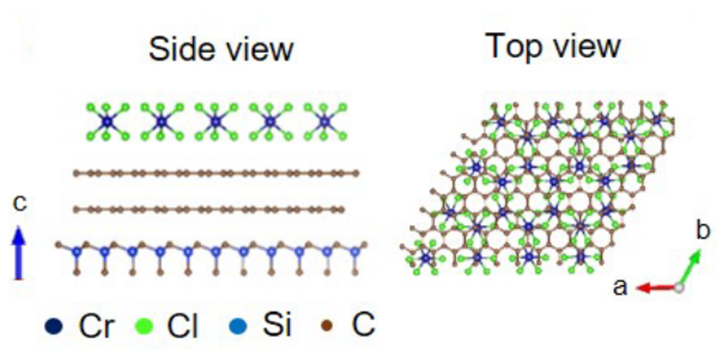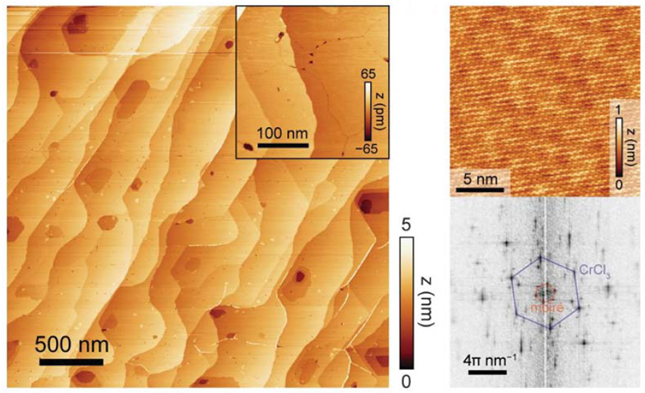Dr. Kai Chang and colleagues publish in Science – Intrinsic 2D-XY ferromagnetism in a van der Waals monolayer
2021/10/29
Abstract: 2D-XY ferromagnetism model is an important platform for the research of fundamental condensed matter physics. In this work, Dr. Kai Chang and colleagues have successfully grown nearly perfect monolayer CrCl3 films, and detected clear evidence of the underlying 2D-XY ferromagnetism. This study has solved the long-standing difficulty of reliable growth and measurement of 2D-XY ferromagnetic materials.
The mechanism of ferromagnetism and the corresponding phase transitions at two-dimensional (2D) limit is a long-standing fundamental question in condensed matter physics. As the size of modern micro/nano electronic devices is approaching the atomic limit, this question has also acquired tremendous importance in applications. Early studies of isotropic Heisenberg model of magnetism claimed that no long-range magnetic order exists in a system with a dimension lower than three. However, further investigations found that long-range magnetic orders can survive with the assistance of magnetic anisotropy. Theoretically, long-range magnetic order can be created in a system with easy plane and continuous rotational symmetry O(2) –a system described by the so-called 2D-XY model– through the formation of bound pairs of vortices and anti-vortices with opposite chirality. As the system is heated over a critical temperature, the pairs are broken and the ferromagnetism is suppressed. A phase transition with such a mechanism is called BKT (Berezinskii-Kosterlitz-Thouless) transition.
Although people have grown many magnetic metal and oxide films, materials that can be well described by 2D-XY model are still rare. This is mainly because most materials suffer from the strong interaction between the film and the substrate, or between the atomic layers inside the film, which makes the easy axis prefer certain in-plane or out-of-plane directions, hence the symmetry requirement of 2D-XY model is not fulfilled. Recently, a series of 2D ferromagnetic materials with van der Waals layered structures, in which the aforementioned interaction can be minimized, have been experimentally discovered. Among these materials, chromium trichloride (CrCl3) is a relatively rare example with easy plane and antiferromagnetic inter-layer coupling. Furthermore, because of its 6-fold rotational crystalline symmetry, it is less likely that its magnetization has preferred directions like that in 2- or 4-fold rotational symmetries. Therefore, CrCl3 is a promising material for the realization of 2D-XY ferromagnetism.

Figure 1. Lattice structure of monolayer CrCl3. Each Cl-Cr-Cl trilayer forms a van der Waals layer of CrCl3. The substrate is single crystalline SiC(0001) covered by epitaxial bilayer graphene.
In order to determine the mechanism of phase transition, people often measure the so-called “critical exponents”. When an ordered system is heated close to the critical temperature Tc, the order parameter, in this case the magnetization M, evolves as M = M0 (1-T/Tc)β, in which β is the critical exponent that is generally believed to be dependent only on the mechanism of phase transition, instead of specific materials. A phase transition can be ascribed to a certain universality class by measuring critical exponents. For example, a continuous phase transition described by Landau mean field theory has a critical exponent β = 1/2; for Ising ferromagnetism that is more common in low-dimensional materials, β = 1/8; while for 2D-XY model, β = 3π2/128 ≈ 0.231.
Although the theory above seems simple and clear, the experimental measurement of critical exponents faces huge technical challenges from both the aspects of the quality of materials and the precision of measurements. Since the thickness of the film is only one van der Waals layer thick, the magnetic signal from the film itself is extremely weak. For the approaches that are only sensitive to the overall magnetization, such as SQUID (superconducting quantum interference device), MOKE (magnetic optical Kerr effect) and electric transport measurement, any tiny magnetic impurities can introduce error signals and lead to huge deviation in critical exponentials. During Dr. Kai Chang’s stay in Max Planck Institute of Microstructure Physics (MPI-MSP), Halle, Germany, he has successfully grown monolayer CrCl3 films with nearly perfect coverage and extremely low defect density on graphene substrates that have very low surface energy by molecular beam epitaxy. Collaborating with the colleagues in MPI-MSP, they have confirmed the 2D-XY ferromagnetism in monolayer CrCl3 by the XMCD (X-ray magnetic circular dichroism) experiments conducted in the synchrotron light sources in ALBA, Barcelona, Spain and BESSY, Helmholtz Center of Materials and Energy, Berlin, Germany. This work has been published in Science recently. Dr. Amilcar Bedoya-Pinto, Dr. Kai Chang and Prof. Stuart S. P. Parkin are the corresponding authors.

Figure 2. Left, scanning tunneling microscopy (STM) topography images of monolayer CrCl3 with nearly perfect coverage. The terraces and steps on the surface are all from the SiC substrate. Right, atom resolved STM image and the corresponding Fourier transformed image, in which the hexagonal lattice of CrCl3 and the moiré pattern between graphene and CrCl3 are resolved.
Different from the approaches that are sensitive only to the overall magnetization, XMCD measures the difference between the X-ray absorption spectra (XAS) excited with left- and right-hand circularly polarized photons, which is element-resolving because each element displays a series of absorption edges at different energies. Distinguishing the magnetic moments contributed by different elements, XMCD can exclude the signal from impurities and extract the intrinsic information from the film itself. The magnetization of monolayer CrCl3 is mainly from Cr atoms, and the XMCD signal displays clear magnetic hysteresis and in-plane/out-of-plane anisotropy. A variable-temperature experiment shows a critical temperature of 13 K. Fitting the XMCD signals near Tc, a critical exponent β = 0.227 is obtained, which is very close to the theoretical value of 0.231 predicted by 2D-XY model. The Arrott-plots at different temperatures and magnetic fields further confirm the 2D-XY ferromagnetism.

Figure 3. Left, the XMCD signal of Cr at a magnetic field of 8 T. Middle, magnetic hysteresis of the XMCD signal of the Cr L3 edge. Clear magnetic anisotropy is observed. Right, the temperature dependence of remnant XMCD signal after the application of an in-plane magnetic field.
The discovery of intrinsic 2D-XY ferromagnetism is of great importance to the studies of the magnetism and spintronics of low-dimensional quantum materials. This work has provided an easy-to-prepare, high crystalline quality, weak inter-layer interaction material that nearly perfectly fits the description of 2D-XY model, which could serve as an experimental platform for the future studies of 2D spin superfluids, topological magnetic orders, etc. This work was supported by National Natural Science Foundation of China (No. 12074038) and German Federal Ministry for Education and Research.
Dr. Kai Chang is currently working as the principal investigator of Low-Dimensional Quantum Materials Team, Division of Quantum State of Matter, BAQIS.
Article URL: https://www.science.org/doi/10.1126/science.abd5146
 中文
中文 Email
Email QCloud
QCloud Log in
Log in
